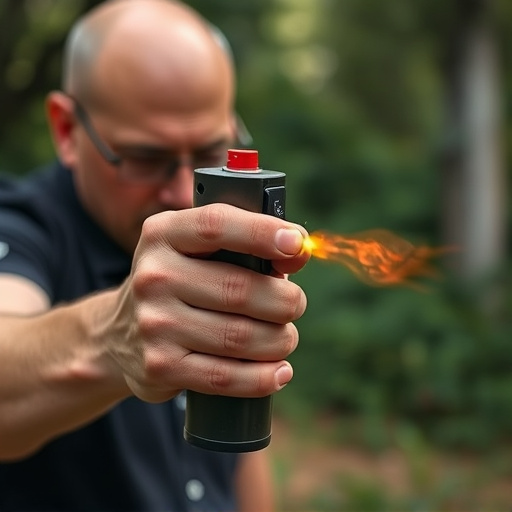Pepper spray, a powerful self-defense tool, temporarily incapacitates attackers, allowing escape. Its active ingredient, capsaicin, causes disorientation and respiratory distress in aggressors. Immediately after use, thorough eye washing and irrigation, deep breathing, and relocation to a clean area are crucial. Medical attention is essential if symptoms persist or severe reactions occur, as effects vary among individuals. Safe usage, proper immediate care (eye flushing for 15+ minutes, cold compresses, hydration), and understanding local laws regarding possession and use are key aspects of effective pepper spray management.
Personal safety is paramount in today’s world, and pepper spray stands as a powerful tool for self-defense. This comprehensive guide delves into the intricacies of using inflammatory pepper spray for personal protection. From understanding its composition and effects to mastering application techniques for immediate care, we equip you with vital knowledge. Learn when and how to deploy this device effectively while exploring post-exposure care, legal considerations, and safe storage practices.
- Understanding Pepper Spray: Its Composition and Effects
- When to Use Pepper Spray for Personal Safety
- Proper Application Techniques for Immediate Care
- Post-Exposure Care and Recovery Strategies
- Legal Implications and Safe Storage Practices
Understanding Pepper Spray: Its Composition and Effects
Pepper spray, a powerful personal safety tool, is designed to temporarily incapacitate an attacker, providing individuals with crucial time to escape potentially dangerous situations. Comprising capsaicin, the active ingredient found in chili peppers, it causes a burning sensation and inflammation in the eyes, nose, and respiratory system. When deployed, pepper spray creates a cloud of irritants that can cause immediate disorientation and difficulty breathing, temporarily neutralizing an aggressor.
Understanding its composition is key to knowing how to respond after use. Immediate care for those exposed involves thorough eye washing and irrigation to flush out the chemicals. Inhaling deeply and moving to a clean area helps alleviate respiratory distress. It’s important to seek medical attention if symptoms persist or severe reactions occur, as pepper spray exposure can have varying effects on different individuals.
When to Use Pepper Spray for Personal Safety
When considering pepper spray as a personal safety tool, it’s crucial to understand its appropriate usage. The immediate care and response required after using pepper spray are essential for ensuring safety. It is designed for use in high-risk situations where an attacker has physically threatened or harmed you, leaving you no other option but to defend yourself. This can include instances of physical assault, sexual harassment, or any scenario where your life or well-being is immediately in danger.
The effectiveness of pepper spray lies in its ability to temporarily disable an assailant by causing severe irritation and pain in the eyes, nose, and respiratory system. It’s important to remember that pepper spray should be used as a last resort when all other means of escaping or de-escalating a situation have failed. Proper training on how and when to deploy it is vital to ensure its safe and successful use.
Proper Application Techniques for Immediate Care
When it comes to immediate care after using inflammatory pepper spray, proper application techniques are crucial. After deployment, quickly assess the situation and ensure your safety first. Then, gently wash the affected area with warm water and mild soap to dilute the spray residue. Avoid using harsh chemicals or rubbing the eyes as this can exacerbate irritation.
For eye exposure, hold the affected eye(s) open and flush them thoroughly under running water for at least 15 minutes. Seek immediate medical attention if vision is impaired. If pepper spray makes contact with skin, apply a cold compress to help reduce swelling and pain. Remember, proper post-application care can significantly alleviate discomfort and speed up recovery, ensuring the focus remains on maintaining personal safety during and after an encounter.
Post-Exposure Care and Recovery Strategies
After exposure to pepper spray, immediate care is crucial. If affected, move to a safe, well-ventilated area and flush your eyes with clean water for at least 15 minutes. This helps dilute the irritant and prevent further damage. Seek medical attention if breathing difficulties, severe pain, or persistent irritation occur.
For post-exposure recovery, stay hydrated by drinking plenty of water. Apply a cold compress to affected areas like eyes and face to reduce swelling. Avoid rubbing the eyes as it can exacerbate irritation. Remove any clothing contaminated with spray, and wash with soap and water. Keep a close watch on symptoms for 24-48 hours, especially if multiple people were exposed, and consult a healthcare provider promptly if necessary.
Legal Implications and Safe Storage Practices
The legal implications of carrying and using pepper spray vary significantly depending on your location, so it’s crucial to understand the regulations in your area before purchasing. Many regions have strict laws regarding who can possess and use such irritants, with specific restrictions on quantities and the purpose for which they can be employed. Breaking these laws can result in severe penalties, including fines or even imprisonment.
Safe storage practices are paramount to prevent accidental discharge and maintain the efficacy of pepper spray. Keep it out of reach of children and in a secure, locked location. Never leave it unattended, and ensure the container is well-sealed to protect against environmental factors that could compromise its performance. In cases of immediate care for pepper spray exposure, thorough eye flushing with clean water for at least 15 minutes is essential. Seek medical attention if respiratory distress or other severe symptoms persist.
Pepper spray is a powerful tool for personal safety, but its effective use hinges on understanding its composition, knowing when to deploy it, and mastering proper application techniques for immediate care. By following post-exposure strategies and being aware of legal implications and safe storage practices, individuals can ensure they’re prepared and equipped to handle unexpected situations effectively. Remember, knowledge is the first step towards empowering yourself with this essential self-defense tool.
